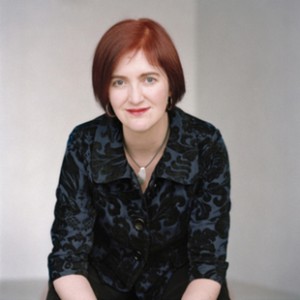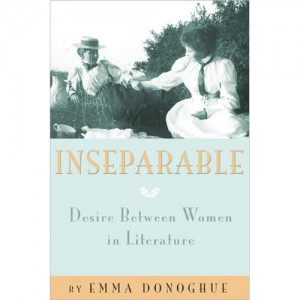
Extensive compendium of lesbian literature explains how we got here from there
by Kit van Cleave
Anyone wanting to research the vast field of women’s relationships now has a one-stop source in Emma Donoghue’s Inseparable: Desire between Women in Literature.
Just out in paperback, Donoghue’s encyclopedic discussion of genres, plots, myths, and tales is sure to set the standard in threading literature from various eras into one highly readable volume. (However, she acknowledges Terry Castle’s 1,100-page The Literature of Lesbianism as “the best available.”)
 Avoiding what she calls “the 21st-century use” of the word lesbian, because it “does not begin to do justice to the variety of women’s bonds in literature from the 1100s to the 2000s,” Donoghue sets up six categories of recurring plot motif:
Avoiding what she calls “the 21st-century use” of the word lesbian, because it “does not begin to do justice to the variety of women’s bonds in literature from the 1100s to the 2000s,” Donoghue sets up six categories of recurring plot motif:
• Travesties – Cross-dressing…causes the “accident of same-sex desire.”
• Inseparables – Two passionate friends defy divisive forces.
• Rivals – A man and a woman compete for another woman’s heart.
• Monsters – A wicked woman seduces and destroys an innocent.
• Detection – Discovery of a crime also uncovers same-sex desire.
• Out – A woman’s life changes when she realizes she loves women.
In each case, Donoghue may start with the earliest work of the motif, then wend her way through various genres up to present writers. Thus, in “Travesties,” the plot may involve a male character who “puts on skirts, winning access to women-only space, and under cover of friendship [woos] a woman who may fear she is falling for one of her own sex.” It’s easy to see this same story worked out in the 1980s films Yentl and Tootsie.
The cleverness of the book’s arrangement of so many eras and genres, and the vast detail covered by this Irish writer, is called “dazzling” by The Washington Post. Donoghue is the author of seven novels, but currently best known for her novel Room, a best-seller and winner of many international awards. She has also published short stories, plays, screenplays, literary history, and edited anthologies. Her doctoral dissertation at Cambridge was on friendship between men and women in 18th-century fiction.
Born in Dublin, Donoghue grew up in a country long admired for a love of writing, reading, and books. She took over a decade to complete Inseparable, after being asked to write a history of lesbian literature. Writers include Chaucer, Shakespeare, Charlotte Bronte, Dickens, Agatha Christie, Sade, Diderot, Balzac, Thomas Hardy, and Elizabeth Bowen, among hundreds of others.
Her breezy discussion of the works she uses for reference may move from Aelfric’s Lives of Saints to Fried Green Tomatoes and Sarah Waters’ Tipping the Velvet. Illustrations showing various political and social eras make the book amusing and erotic.
Part of the fun of reading this book is seeing how plots which early on seem impossibly creaky start to turn into today’s vampire legends (Twilight et al) or provide subtext for films or characters appearing on this year’s Screen Actors Guild or critics’ lists (The Girl with the Dragon Tattoo).
This is a must-have and must-read for all lesbians and lesbians-in-training. As Donoghue warns her readers in the opening pages of Inseparable, “The past is a wild party; check your preconceptions at the door.”
Kit van Cleave is a freelance writer living in Montrose. She has published in local, national, and international media.











FB Comments